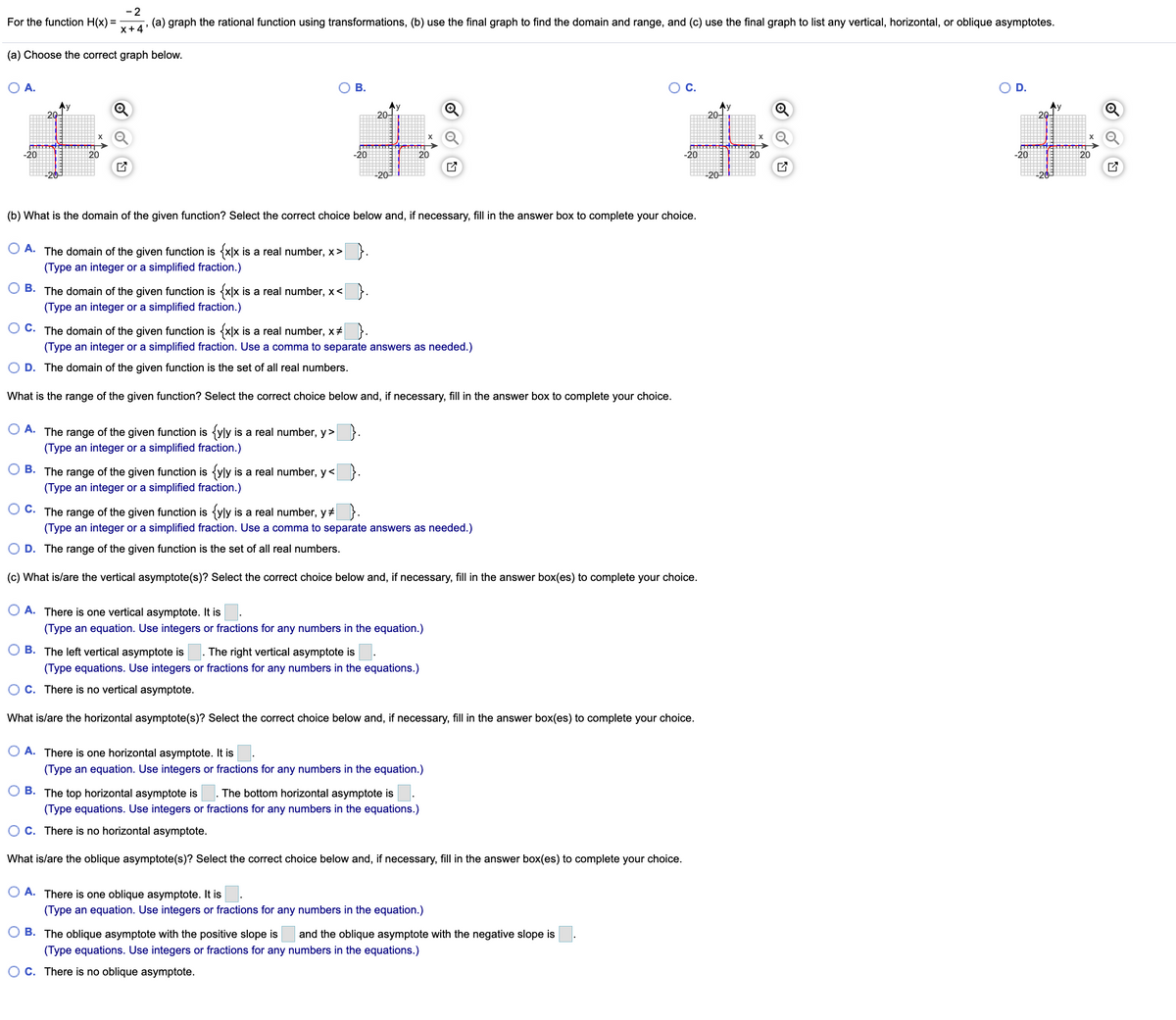-2 For the function H(x) = 4: (a) graph the rational function using transformations, (b) use the final graph to find the domain and range, and (c) use the final graph to list any vertical, horizontal, or oblique asymptotes. (a) Choose the correct graph below.
-2 For the function H(x) = 4: (a) graph the rational function using transformations, (b) use the final graph to find the domain and range, and (c) use the final graph to list any vertical, horizontal, or oblique asymptotes. (a) Choose the correct graph below.
Functions and Change: A Modeling Approach to College Algebra (MindTap Course List)
6th Edition
ISBN:9781337111348
Author:Bruce Crauder, Benny Evans, Alan Noell
Publisher:Bruce Crauder, Benny Evans, Alan Noell
Chapter5: A Survey Of Other Common Functions
Section5.6: Higher-degree Polynomials And Rational Functions
Problem 14E
Related questions
Question

Transcribed Image Text:- 2
(a) graph the rational function using transformations, (b) use the final graph to find the domain and range, and (c) use the final graph to list any vertical, horizontal, or oblique asymptotes.
For the function H(x) =
x+4'
(a) Choose the correct graph below.
O A.
В.
OC.
D.
20-
Ay
20-
20-
20-
-20
20
-20
-20
20
-20
20
20
(b) What is the domain of the given function? Select the correct choice below and, if necessary, fill in the answer box to complete your choice.
O A. The domain of the given function is {x|x is a real number, x> }.
(Type an integer or a simplified fraction.)
B. The domain of the given function is {x|x is a real number, x< }.
(Type an integer or a simplified fraction.)
O C. The domain of the given function is {x\x is a real number, x+ }.
(Type an integer or a simplified fraction. Use a comma to separate answers as needed.)
D. The domain of the given function is the set of all real numbers.
What is the range of the given function? Select the correct choice below and, if necessary, fill in the answer box to complete your choice.
O A. The range of the given function is {yly is a real number, y> }.
(Type an integer or a simplified fraction.)
O B. The range of the given function is {yly is a real number, y< }.
(Type an integer or a simplified fraction.)
O C. The range of the given function is {yly is a real number, y# }.
(Type an integer or a simplified fraction. Use a comma to separate answers as needed.)
D. The range of the given function is the set of all real numbers.
(c) What is/are the vertical asymptote(s)? Select the correct choice below and, if necessary, fill in the answer box(es) to complete your choice.
O A. There is one vertical asymptote. It is
(Type an equation. Use integers or fractions for any numbers in the equation.)
B. The left vertical asymptote is . The right vertical asymptote is
(Type equations. Use integers or fractions for any numbers in the equations.)
O C. There is no vertical asymptote.
What is/are the horizontal asymptote(s)? Select the correct choice below and, if necessary, fill in the answer box(es) to complete your choice.
A. There is one horizontal asymptote. It is
(Type an equation. Use integers or fractions for any numbers in the equation.)
B. The top horizontal asymptote is
The bottom horizontal asymptote is
(Type equations. Use integers or fractions for any numbers in the equations.)
O C. There is no horizontal asymptote.
What is/are the oblique asymptote(s)? Select the correct choice below and, if necessary, fill in the answer box(es) to complete your choice.
A. There is one oblique asymptote. It is
(Type an equation. Use integers or fractions for any numbers in the equation.)
B. The oblique asymptote with the positive slope is
and the oblique asymptote with the negative slope is
(Type equations. Use integers or fractions for any numbers in the equations.)
O C. There is no oblique asymptote.
Expert Solution
This question has been solved!
Explore an expertly crafted, step-by-step solution for a thorough understanding of key concepts.
Step by step
Solved in 2 steps with 1 images

Knowledge Booster
Learn more about
Need a deep-dive on the concept behind this application? Look no further. Learn more about this topic, calculus and related others by exploring similar questions and additional content below.Recommended textbooks for you

Functions and Change: A Modeling Approach to Coll…
Algebra
ISBN:
9781337111348
Author:
Bruce Crauder, Benny Evans, Alan Noell
Publisher:
Cengage Learning

College Algebra
Algebra
ISBN:
9781305115545
Author:
James Stewart, Lothar Redlin, Saleem Watson
Publisher:
Cengage Learning

Algebra & Trigonometry with Analytic Geometry
Algebra
ISBN:
9781133382119
Author:
Swokowski
Publisher:
Cengage

Functions and Change: A Modeling Approach to Coll…
Algebra
ISBN:
9781337111348
Author:
Bruce Crauder, Benny Evans, Alan Noell
Publisher:
Cengage Learning

College Algebra
Algebra
ISBN:
9781305115545
Author:
James Stewart, Lothar Redlin, Saleem Watson
Publisher:
Cengage Learning

Algebra & Trigonometry with Analytic Geometry
Algebra
ISBN:
9781133382119
Author:
Swokowski
Publisher:
Cengage